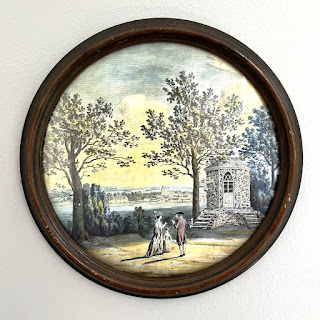A 19th century painting showing John Scott looking through a telescope at the Ware valley
In 2007 I wrote here about a prospect poem by John Scott of Amwell; I then added a postscript with more information in 2015. This is a further postscript really, but I'm writing a fresh blog post because I recently visited Ware and saw the summer house and grotto he built there. These are preserved in a fragment of what was once his extensive garden, leading down to the New River, which flows here alongside the Lea (they are now separated by the railway). For £2 you can enter and look around - the picture below shows the flint summer house, an 'airy octagon,' which would have provided a prospect of the vale. Scott wrote of the evening view here, of 'sun-gilt lands, / Of bright green pastures, stretch'd by rivers clear, / And willow groves, or other islands clear.' Today this prospect is obscured by trees and 1960s houses, although it could have been worse. The local developer was planning to bulldoze the grotto 'and erect Nos. 30-32 Scott’s Road on the site. The porch and dome of the Council Chamber were demolished, the summerhouse was damaged and the grotto was heavily vandalised.' The restoration work that has happened since then is really impressive.
David Perman's detailed biography of Scott provides further information on the grotto and Scott's nature poetry, which was generally rather conventional, looking backwards to the era of James Thomson rather than anticipating the Romantic period to come. In reading this I was very surprised to learn that Scott had seemingly written about the great Chinese poet Li Bai in: 'Li-po : or, The good governor : a Chinese eclogue'. He can't have known the poetry, but maybe he had come across the name in a history of China? Regrettably, Scott doesn't actually refer to him as a poet and the details in the poem are hazy and don't correspond to the real life of Li Bai. The poem begins with the design of a pavilion - like Scott, Chinese literati were keen on building homes with good views and this Li-Po does not neglect to include a grotto. 'Bright shells and corals varied lustre shed; / From sparry grottos chrystal drops distill'd / On sounding brass, and air with music fill'd...' I'll conclude here with the landscape beyond the garden of Li-Po, a description familiar from eighteenth century chinoiserie, but also perhaps an imaginary equivalent to the river view Scott was able to enjoy.
The distant prospects well the sight might please,With pointed mountains, and romantic trees:From craggy cliffs, between the verdant shades,The silver rills rush'd down in bright cascades;O'er terrac'd steeps rich cotton harvests wav'd,And smooth canals the rice-clad valley lav'd;Long rows of cypress parted all the land,And tall pagodas crown'd the river's strand!



No comments:
Post a Comment